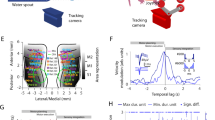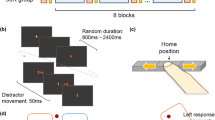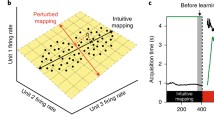Abstract
We examined neuronal activity in three motor cortical areas while a rhesus monkey adapted to novel visuomotor transforms. The monkey moved a joystick that controlled a cursor on a video screen. Each trial began with the joystick centered. Next, the cursor appeared in one of eight positions, arranged in a circle around a target stimulus at the center of the screen. To receive reinforcement, the monkey moved the joystick so that the cursor contacted the target continuously for 1s. The video monitor provided continuous visual feedback of both cursor and target position. With those elements of the task constant, we modified the transform between joystick movement and that of the cursor at the beginning of a block of trials. Neuronal activity was studied as the monkey adapted to these novel joystick-cursor transforms. Some novel tasks included spatial transforms such as single-axis inversions, asymmetric double-axis inversions and angular deviations (also known as rotations). Other tasks involved changes in the spatiotemporal pattern and magnitude of joystick movement. As the monkey adapted to various visuomotor tasks, 209 task-related neurons (selected for stable background activity) showed significant changes in their task-related activity: 88 neurons in the primary motor cortex (M1), 32 in the supplementary motor cortex (M2), and 89 in the caudal part of the dorsal premotor cortex (PMdc). Slightly more than half of the sample in each area showed significant changes in the magnitude of activity modulation during adaptation, with the number of increases approximately equaling the number of decreases. These data support the prediction that changes in task-related neuronal activity can be observed in M1 during motor adaptation, but fail to support the hypothesis that M1 and PMdc differ in this regard. When viewed in population averages, motor cortex continued to change its activity for at least dozens of trials after performance reached a plateau. This slow, apparently continuing change in the pattern and magnitude of task-related activity may reflect the initial phases of consolidating the motor memory for preparing and executing visuomotor skills.
Similar content being viewed by others
Author information
Authors and Affiliations
Additional information
Received: 26 August 1997 / Accepted: 13 February 1998
Rights and permissions
About this article
Cite this article
Wise, S., Moody, S., Blomstrom, K. et al. Changes in motor cortical activity during visuomotor adaptation. Exp Brain Res 121, 285–299 (1998). https://doi.org/10.1007/s002210050462
Issue Date:
DOI: https://doi.org/10.1007/s002210050462




